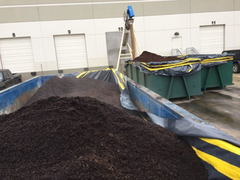The importance of a simple cup of coffee cannot be understated as a farmer. It provides many farmers the morning jolt after getting some well-deserved “Z’s” after a typical day of work on the farm. The warming liquid was essential for my 4:30 am mornings and an essential pick me up at midday when it was time to transition from the morning tasks on the farm to the business tasks required behind the desk. I understand the importance of it for myself when it came to simple energy but discovered its true value when I started utilizing it on a commercial scale in my compost pile and for my plants indoors and outdoors.
That works for a small-scale farming system sure, but what about indoor grows or commercial cannabis farms? Can it be a commercially viable soil source? Can it grow outstanding, nutrient dense plants? Can a Texas company find an agricultural solution for industrial coffee waste?

Coffee & Circular Economics in Agriculture
Cup o’ Joe, Morning Brew, Wake-Up Juice, Java, Café, Bean Juice, the list goes on for the common slang words used as nicknames for coffee, but one thing is for certain, people love drinking it and it is a staple for many households and businesses alike. 7 out of 10 Americans drink coffee every day. The average coffee café utilizes over 12 pounds of coffee daily. That equates to over 4,300 pounds of spent coffee grounds produced annually. [i] For every 2.20 pounds of new ground coffee used it produces 4.18 pounds of spent coffee grounds that has to be handled. How do most consumers, coffee shops, and industrial beverage producers handle the tremendous amount of waste produced by the delicious beverage that over 62% of Americans enjoy on a daily basis? [ii] Unfortunately, it has been found that 93% of that waste goes directly to the landfill. What does that mean?
This means according to some estimates, around eighteen million tons of used coffee grounds go to landfill each year.
However, when coffee grounds break down in landfill sites they emit methane, a greenhouse gas up to 28 times more damaging than carbon dioxide. This poses serious problems to the planet due to global warming. [iii]Out of the 20 billion pounds of coffee produced around the world will be contributing to methane production in landfill rather than being utilized in a circular economics system. [iv] It also means that 558 million pounds of nitrogen, 1.1 million pounds of phosphorous, and over 111 million pounds of potassium that can be potentially utilized for agricultural purposes but rather sits dormant in landfills creating nutrient runoff and pollution because it us not placed into a circular economic system.[v]
What is circular economics and how can it be utilized in agriculture? The basic principle of circular economics is that waste becomes a resource but rather a byproduct for another use. Ask any experienced organic farmer about their farm system and they will tell you that they know exactly what comes into their farm and what purpose it serves, from the seeds, the soil components, and
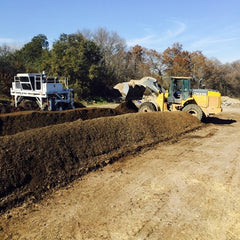
equipment and they will tell you exactly what comes out and at what point. The agriculture sector is very unique and utilizes mostly natural resources for ideal product production. Unfortunately, the standardization of agricultural production has created a reliance on technical nutrients and away from biological or natural nutrient sources. This adoption by traditional agriculture has created a more linear approach to production. Most companies harvest and extract resources or materials and use it to manufacture a product that is sold to a consumer that later discards the product once it is used or no longer serves a purpose. This economic flow relies heavily on high-intensity exploration, overseas production, and consumptions of resources at a high-intensity damage to the environment.[vi]
Think of the idea that allowed early European settlers to adapt to the unfamiliar terrain of early American soil. The use of using rotting fish heads in the soil prior to planting corn. [vii] They learned to eat majority of the fish but put the “waste” to work to grow crops that sustained their long-term settlement goals and created one of the first circular economies in the Americas. But what exactly does it mean for today’s modern farms, landscapers, or gardeners? What does coffee have to do with the push to create a more circular economic system literally from the roots up in a farm system? The answer is inside the very cup that farmers enjoy every morning.
Industrial Coffee Waste Turned into Soil
Much like the story of the fish heads being utilized used in early settlers’ life much of the story is surrounded by myth but one thing remains true, the nutrient

content and biological reaction the soil has to the decaying fish increases the plants nutrient availability and promotes healthy soil growth that in turn creates healthy soil growth. [viii]These early principles in agriculture have created industries around utilizing waste from fisheries, canneries, and processors around the world and turning into a productive soil nutrient essential for growing healthy soil systems that produce nutrient dense crops.
The growing popularity of cold-brewed coffee and the increased demand for coffee has created a unique opportunity for Chad McNair, CEO of Aspen Beverage Group in San Antonio and David Mayer, owner of Mayer Materials in Fort Worth to the creation of a company, Texas Java Partners LLC, that research, develop and produces innovative coffee-based fertilizers, composts, and organic matter root-zone amendment products.

Coffee waste is produced every single day at staggering rates throughout the world and there is not enough being done to remediate that waste and divert it from landfills. Texas Java Partners LLC teamed up with Texas A&M AgriLife Research’s Doctor Ben Wherley to conduct an experiment with the spent coffee ground to divert waste from industrial coffee beverage manufacturing from landfills and rather use it in commercial agriculture. It was found that coffee grounds can cover a lot of ground. Wherley said Aspen Beverage Group supplied much of the spent coffee grounds for his team’s research projects, which looked at the cast-off products as a surface application, perhaps as a fertilizer or compost, and as a soil root-zone amendment in sand-based systems.
Spent coffee grounds have about a 2.5-3 percent nitrogen content, and a carbon-to-nitrogen ratio of about 20 to 1, which seemingly could make them desirable for fertilizer application, Wherley said. The two-year topdressing fertilizer study tested seven different organic and synthetic fertilizers against coffee grounds — fresh and composted — as well as a control. The study also tested two application rates for each treatment.
“Our observation from this study determined that direct application of spent coffee grounds by themselves provided minimal benefit,” Flores said. “However, when the spent coffee grounds were added with another source of fertility, the nutrients appear to be retained over an extended period compared to organic and especially synthetic fertilizers.”[ix]
This discovery can immediately create a more sustainable and effective nutrient availability in an emerging cannabis soil marketplace. The realization of agricultural products being developed from industrial coffee waste was born and has positive effects for the cannabis industries ecological and sustainable footprint alike.

Comanche Compost Co. is Good Medicine for the Good Grow
Born out of necessity in North Texas to make sure we do our part in creating a sustainable future of soil utilizing in commercial cultivation of cannabis and turf grass through our parent company GeoJava. Comanche Compost products are unlike any other. Our premium ingredients: Pure Coffee Grounds, Coffee Chaff, Tea, & Alfalfa and our formulated microbiology are what make our composts unique. These acidic, living, quality composts are the foundation for all of our products.
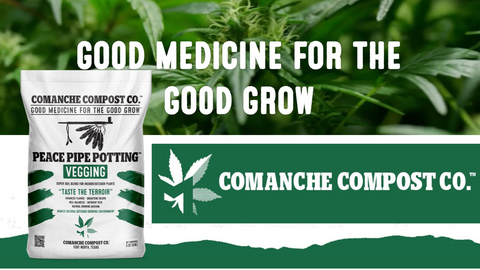
Comanche Compost Co. originated in Parker County, Texas which is the very ground where the eastern most frontier collided with the unchartered western territories of Comancheria for over 100 years. Forever anchored to this rugged land in both family name and in legend is the last, greatest Comanche Chief, Quahna Parker. Quahna Parker’s story is undeniably one of the most remarkable in all of Native American history. It’s a story of growth, expansion, change, adaptation and perseverance against all odds.
In this spirit, Comanche Compost Co. was founded to offer growing solutions that combine the generational knowledge of outdoor growers from the Pacific Northwest with the latest emerging techniques and methodologies arising from the indoor growing culture of the Southwest to produce undeniable results. In a nutshell, we incorporate new science-based cultivation methods with old craft growing techniques to create proven products that produce results.
Our products are living soil blends, composts, organic dry fertilizers & plant stimulants which are all naturally rich in organic nutrients, acids & enzymes, and teaming with specific microbes. Our unique recipes are proven to support consistent growth from seed germination, all the way through to harvest, with a hyper-focus on the development of potency, flavors, and aromas of the end product. We combine the spiritual with the scientific to produce an undeniable difference in every product.
We are not only good stewards for the good grow but also of the earth. Our products are designed to leave the earth better then we found it. We are always pushing the limits on what we can do to limit our dependence on peat moss and other unsustainable growing products to leave the industry in a better place than when we found it.[x]
Peace Pipe Potting Mix
This is only one of the products offered by Comanche Compost Co. that utilizes the GeoJava technology as well as other natural amendments that create unique terroir that you can taste in the final buds of your grow. It provides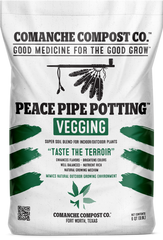 maximum amount of nutrients a soil can handle without running the risk of plant burn. This blend is specifically designed to be used in outdoor pots to support large plants with very heavy feeding demands and is constructed to have extra porous spacing and drains exceptionally well. The ingredients of the Peace Pipe Potting Mix consist of Sphagnum Peat Moss, Horticulture Perlite, Aged Pine Bark, Good Medicine Compost, Worm Castings, Composted Coffee Grounds, Norwegian Seaweed Extract, Utah Humates, Texas Green Sand, Gypsum, and Poultry Meal.
maximum amount of nutrients a soil can handle without running the risk of plant burn. This blend is specifically designed to be used in outdoor pots to support large plants with very heavy feeding demands and is constructed to have extra porous spacing and drains exceptionally well. The ingredients of the Peace Pipe Potting Mix consist of Sphagnum Peat Moss, Horticulture Perlite, Aged Pine Bark, Good Medicine Compost, Worm Castings, Composted Coffee Grounds, Norwegian Seaweed Extract, Utah Humates, Texas Green Sand, Gypsum, and Poultry Meal.
In conclusion through the promotion of circular economics and the industry support of those products can create a greener future.
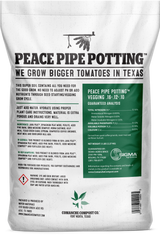
Cannabis is mainstream, the industry is booming but its earthy and all-natural branding doesn’t tell the whole story. You thought your cannabis came from environmentally conscious hippies? Think again. The way cannabis is currently being grown in America, it turns out, is anything but sustainable and organic. To meet the $30B demand cannabis is being grown relying on massive amounts of energy, heavy doses of agro-pesticides and fertilizers which can cause dire effects on the natural world around the grow site. From wastewater runoff to the emissions load required to import raw materials from out of country there must be something done to reduce to negative effects of growing cannabis.
More growers, companies, and lawmakers alike are noticing that growing green isn’t as green as it is made out to be. The growers that adapt to certifications, utilizing sustainable growing solutions, and embrace nature will prevail over linear cultivators who utilize single use nutrients and growing methods. Comanche Compost Co. will be a leader in the agricultural amendment industry by providing products that promote circular economics and providing growers who want to take their plants production to the next level. We believe that every grower that utilizes our products can turn their soil into a living system that creates award winning terpene profiles and cannabinoid development. From coffee cups to cannabis cups, Comanche Compost Co. creates Good Medicine for the Good Grow.
Thanks for reading and if you have any questions about Comanche Compost’s products please click here and reach out to our team. We are serving Arizona, New Mexico, Oklahoma, and Texas markets right now commercial growers, grow stores, and hobby growers alike. Comanche Compost™ is a agricultural company founded on the idea of utilizing circular economics to create a commercial cannabis fertilizer that provides Good Medicine for The Good Grow.
Sources
[i] Coffee 4 Planet Ark: Final Report for the City of Sydney January 2016, This document reports the findings of a six-month feasibility study into the commercial viability of recycling spent coffee grounds from cafes and coffee shops within the City of Sydney. Planet Ark Environmental Foundation conducted the study through funding from the City of Sydney’s Innovation Grant. Retrieved October 22, 2021.
[ii] NCA releases Atlas of American Coffee – 26 March 2020 | NEW YORK – The National Coffee Association (NCA) today (Thursday) unveiled the most comprehensive survey ever of American coffee drinking habits, showing American coffee drinking has reached new highs and is essential to daily lives coast-to-coast. Retrieved October 22, 2021.
[iii] Circular economy: How can used coffee grounds be reused? Matteo Pavoni, June 2, 2021, Reducing the impact on the environment of used coffee grounds is imperative. Not only is it up to consumers to take action, but it is also the responsibility of café owners and specialty roasters. Retrieved October 22, 2021.
[iv] Coffee: here’s the carbon cost of your daily cup – and how to make it climate-friendly January 2021, Over 9.5 billion kg of coffee is produced around the world each year, with a total trade value of US$30.9 billion. Global coffee demand is expected to triple production by 2050, raising pressure on forests and other habitats in the tropical regions where it’s grown as farmers look for new land to till. Retrieved October 22, 2021
[v] Add Used Coffee Grounds to Your Garden Soil and Get Amazing Results Green Living, June 26, 2006, Used coffee grounds make good soil amendments. That’s the buzz among gardeners lately. But what do your coffeepot’s leftovers really add to the soil? Retrieved October 22, 2021 The nitrogen, phosphorus, potassium “guaranteed analyses” would be as follows for the coffee grounds: Nitrogen: 2.28 percent Phosphorus: 0.06 percent Potassium: 0.6 percent. Available nutrient levels: The pH or reaction of the coffee grounds is considered slightly acidic and in a favorable range at 6.2 on the pH scale.
[vi] Circular Economics In Agriculture: March 4th, 2019, Nicolette Mathews University of the Free State In the EU, the US and China, the development of models and strategies to move towards a circular agricultural production approach has gained significant momentum over the last decade. Although South Africa has adopted some elements of a circular economy, the adoption of a truly circular economy is still a long way off.
[vii] A Thanksgiving Fish Story: Talking Fish November 2013, Many people know the Thanksgiving legend of Squanto (Tisquantum), the Native American who taught Pilgrims how to plant crops and survive in New England. But not many know that Squanto’s legend is a fish story—in more ways than one. Retrieved October 22, 2021
[viii] All You Need To Know About Fish Fertilizer, Pennington Seed Inc. 2019 All plants need fertile, biologically-active soil to thrive. Fish fertilizer offers the immediate benefit of plant food with the long-lasting effect of increased microbial activity in the soil. As you prepare your growing space for the next season, consider adding fish fertilizer to your planting and maintenance schedule.
[ix] Repurposed Coffee Grounds Can Benefit Turfgrass and Landscapes April 2020, Ben Wherley, Texas A&M AgriLife Research turfgrass ecologist in the Texas A&M Department of Soil and Crop Sciences, College Station, has taken advantage of the growing popularity in cold-brewed coffee and the truckloads of spent coffee grounds not previously available. Retrieved October 22, 2021.
[x] About Comanche Compost Everything you need to know about the story of Comanche Compost and their value driven mission to provide great soils derived from industrial coffee waste. From your coffee cup to cannabis cup, Comanche Compost provides Good Medicine for the Good Grow. Retrieved October 22, 2021.
